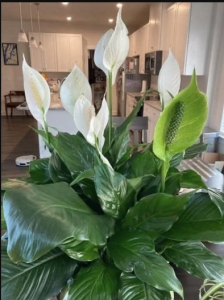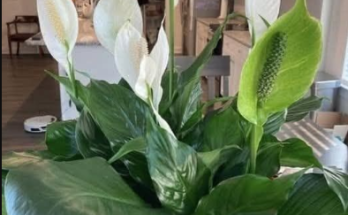
How to Get Your Peace Lily to Flower More: A Complete
The peace lily—elegant, glossy, and famous for its stunning white blooms—is one of the most beloved indoor plants in the world. But while its lush leaves grow easily, many owners find themselves wondering why their plant isn’t producing flowers. Weeks pass, then months, and still no blooms appear. If your peace lily has gone quiet, don’t worry: the secret to encouraging more flowers lies in understanding what the plant needs, what triggers blooming, and how small changes can make a huge difference.
Getting a peace lily to flower more isn’t complicated, but it requires the right combination of light, watering, temperature, feeding, and potting conditions. With patience and proper care, you can turn a foliage-only plant into a reliable bloomer that produces elegant white “spathe” flowers several times a year. Here’s everything you need to know.
1. Understanding How Peace Lilies Flower
Peace lilies don’t bloom simply because they are healthy—they bloom when their environment mimics the conditions that trigger flowering in nature. In the wild, they grow in bright tropical understories where they receive filtered but consistent light, warm temperatures, and rich, moist soil. When these conditions are reproduced indoors, the plant responds with blooms.
A key fact: Peace lilies typically bloom twice a year, usually in spring and again in early fall. If your plant hasn’t flowered, it’s usually because one or more of its environmental conditions are off.
2. Give It More Light — The #1 Requirement
Most people keep peace lilies in low-light rooms because they tolerate shade. Yes—they survive low light, but they do not flower in low light.
What They Need
-
Bright, indirect light
-
A location near a window with filtered sun
-
A spot where the plant gets 2–4 hours of gentle morning light
Too much light can scorch the leaves, but too little prevents blooming completely.
Signs It Needs More Light
-
Dark, slow-growing leaves
-
No flowers for 6–12 months
-
Leaning toward a window
-
Thin, stretched stems
Best Spots in a Home
-
Near an east-facing window
-
A few feet from a south or west window with sheer curtains
-
A bright room where you can read during the day without turning on lights
If you give your peace lily proper lighting, you’ve already solved 70% of the blooming problem.
3. Water Correctly — Not Too Much, Not Too Little
Peace lilies like consistently moist soil—but not soggy. Watering mistakes are the second most common reason they won’t bloom.
Best Watering Routine
-
Water when the top 1 inch of soil dries out
-
Use room-temperature water
-
Ensure the pot has drainage holes
Peace lilies hate sitting in water. Overwatering suffocates the roots and stops blooming.
Watch for These Signs
Underwatering:
-
Drooping leaves
-
Brown tips
-
Slow growth
Overwatering:
-
Yellow leaves
-
Mushy stems
-
Persistent wet soil
A balanced watering routine supports steady, healthy growth—and healthy growth leads to more flowers.
4. Warm, Stable Temperatures Are Essential
As tropical plants, peace lilies don’t like sudden temperature changes. Stress equals fewer flowers.
Temperature Guidelines
-
65–80°F (18–27°C) during the day
-
No lower than 55°F (13°C) at night
-
Keep away from cold drafts, heaters, and air conditioners
Even a few days of cold stress can delay flowering for months.
5. Feed Your Peace Lily — Fertilize Lightly but Consistently
Peace lilies don’t need heavy feeding, but they do need nutrients to bloom.
Best Fertilizer
-
A balanced liquid fertilizer
-
Example ratios: 10-10-10 or 20-20-20
-
Or a bloom booster with lower nitrogen, like 7-9-5
How Often to Feed
-
Every 4–6 weeks during spring and summer
-
Do NOT fertilize in winter, when growth slows
Over-fertilizing burns roots and stops blooms, so always dilute fertilizer to half strength.
6. Repot When Needed — A Root-Bound Lily Won’t Bloom
If your peace lily is root-bound, it focuses on survival, not flowering.
Signs It Needs Repotting
-
Roots growing out of the drainage holes
-
Water runs straight through the pot
-
Soil dries out extremely fast
-
The plant seems too large for the pot
How to Repot
-
Choose a pot 1–2 inches larger than the current one
-
Use well-draining potting mix
-
Repot in spring, the natural growth season
Fresh soil with renewed nutrients often triggers new blooms within a few months.
7. Clean the Leaves to Help Photosynthesis
Dirty or dusty leaves reduce light absorption, which reduces energy for flowering.
How to Clean the Leaves
-
Wipe each leaf gently with a damp cloth
-
Or give the plant a light shower every few weeks
Cleaner leaves = healthier plant = more flowers.
8. Remove Spent Flowers and Old Leaves
Dead or aging parts waste energy. Removing them redirects strength to new growth and blooms.
How to Prune
-
Cut old blooms at the base of the stalk
-
Cut yellow, brown, damaged, or limp leaves
-
Use sterilized scissors
This keeps the plant tidy and encourages fresh blooms.
9. Give It Time — Peace Lilies Bloom in Cycles
Even with perfect care, peace lilies bloom in natural cycles. They typically produce flowers:
-
In spring, and
-
Possibly again in late summer or early fall
If yours hasn’t bloomed yet, it may simply be waiting for its cycle to begin.
10. Bonus Tip: Use Grow Lights in Dark Homes
If your space doesn’t offer bright indirect light, consider a grow light:
-
Set it for 10–12 hours per day
-
Keep it 12–18 inches above the plant
Grow lights can revive a plant that hasn’t bloomed for years.
Conclusion: Your Peace Lily Can Bloom Again
Peace lilies reward consistency. When you offer the right light, water, temperature, nutrients, and space, they respond with lush green leaves and stunning white flowers that last for weeks.
To get your peace lily to flower more often, focus on:
-
Bright indirect light
-
Consistent but not excessive watering
-
Warm temperatures
-
Light, regular fertilizing
-
Occasional repotting
-
Leaf cleaning and pruning
-
Patience with the natural blooming cycle
With these steps, your peace lily will not only bloom—it will thrive, flourish, and transform your space with its serene beauty.


